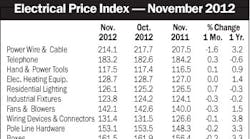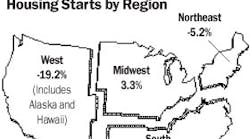Latest from Mag
Part 1 of the Insider’s Outlook in Electrical Wholesaling’s December issue explored the 2008 economy, acquisition climate for distributors and manufacturers. Here’s a preview of part 2, which will offer some insight into what industry executives see on the price of copper and other base metals, basic operating costs, the green movement and the legislative picture on Capitol Hill.
Price of copper and other metals: impossible to guess.
Don’t drain your savings for your kids’ or grandkids’ college education and load up on wire and cable just yet. Even the experts really don’t know which way the finicky prices for copper will swing in 2008. When asked to forecast copper pricing over the coming year, several of our sources said their crystal balls had gone dark.
“I have felt for a long time that commodity prices were way too high, but they haven’t fallen to traditional levels yet,” says Bill Elliott, president, Elliott Electric Supply, Nacogdoches, Texas. “Smarter people than me have tried to predict the copper market unsuccessfully. My recommendation is to buy only what you need to service the market and price at replacement cost.”
Across the country, Bill Goodwin, president, Griffith Electric Supply, Trenton, N.J., says his customers are very concerned about the price of commodities in general and copper in particular. “It’s difficult for them to quote a job that requires a large wire purchase, because no one knows what the price of wire will be next week, let alone six months from now,” he says. “In a recent plant visit to a major wire producer, I asked that question to the president of that company. He was brutally honest and admitted that he had no idea where copper was headed.”
Joe Carroll, Midwest regional manager, Arlington Industries, Olathe, Kan., says because so many external factors control the price of copper and other metals used in the manufacture of electrical products, nothing is ever certain. “Copper has fallen recently after see-sawing around all year,” he says. “A mine flood or strike could cause high demand instantly. Transportation costs are going up everyday, as well as high demand from China and India. Infrastructure development in those countries is double the rate of the rest of the world, and is causing higher demand and higher prices.”
Working for a fittings manufacturer, Carroll also monitors zinc prices very closely. “Zinc has been dropping significantly all year, after record highs in late 2006,” he says. “Prices have not been impacted very much in the market, due to the high demand for steel as opposed to zinc products. That could change if further reductions in zinc are coming in 2008.”
In addition to concerns about the prices of base metals, several respondents were watching transportation and energy costs, too. Jerry Hagerman, senior sales operation manager/IC channel, Sylvania, Danvers, Mass., says the greatest cost impact for Sylvania and other lighting manufacturers will be not only from rising gasoline prices, but other types of energy and especially natural gas. “Those cost increases have also been substantial, and will have an even more significant impact on lamp producers than gasoline, he says.
Green is good.
Several respondents said they hoped the increased interest in energy-efficient electrical products would open up new revenue streams for their companies. Sylvania’s Hagerman says the LEED movement (Leadership in Energy and Environmental Design) is continuing to be a major component in all design and retrofit projects. He expects LEED projects to grow significantly over the next few years, as customers factor in sustainability, environmentally friendliness and energy saving into their buying decisions. “It’s no longer just the price of a product, but also performance, with performance now having a definition that includes this green criteria,” says Hagerman.
When ranking the biggest challenges in 2008 for his company, Julian Corsello, vice president, City Electric Supply, Syracuse, N.Y., says capitalizing on sales opportunities in the green market rank right up there with maintaining his company’s inventory edge, employee training and rising health-care costs. The company recently created a new logo for any event featuring a “green” theme and has completed EPact certifications with two customers as well. City Electric Supply is a major player in upstate New York’s lighting market, and has won a $10,000 prize from the New York State Energy Research and Development Authority (NYSERDA) for having the most qualifying projects supplied in NYSERDA’s Small Commercial Lighting Program by a large supplier/distributor.
Eric Haines, president Haines Sales Corp., East Syracuse, N.Y., has noticed more interest recently in the green market in upstate New York, including City Electric’s green initiative; a large LED lamp job; new start-up companies in the photovoltaic business; several residential and utility-sized wind farms; more LEED projects; and a large conventional contractor buying a green business.
Politics not quite as usual.
While the recently passed energy legislation is widely expected to create new sales opportunities for distributors, reps, manufacturers, contractors and other end users, business lobbyists are concerned about some of the other legislation being discussed by the Democratic majorities in Congress. Because it’s widely acclaimed as one of the most effective lobbying groups on Capitol Hill, the National Association of Wholesaler-Distributors (NAW), Washington, D.C., NAW executives are always up to their elbows in the business legislation that will have the most impact on distributors. 2008 will be no different, says Jade West, NAW’s senior vice president. She expects major debates this year on taxes that affect Subchapter S partnerships, a potentially “massive” inventory tax related to LIFO accounting rules, and possibly some discussion on ergonomics standards. She says Republican leaders are concerned about losing more seats in Congress in the November elections because of the retirements of several key legislators and the current political environment. West urges all business leaders to get involved this year and support their candidates. “If the business community doesn’t maximize vote and participate in electoral process, they are going to have trouble,” she says.
Innovation in any economy floats all boats.
Even in an uncertain economic environment, good old-fashioned innovation can provide distributors and reps with new sales opportunities, says Arlington Industries’ Joe Carroll. In 2008, his company plans to launch new products every 45 days to 60 days, following up the 20 new products it introduced in 2007. He says Arlington Industries intends to back up the launches with effective trade magazine advertising, a liberal free-sample policy, proactive agent/customer training and adequate product stocks ready to ship the same day as the order.
“Arlington Industries will continue to aggressively design and develop new and innovative products for 2008,” he says. “Currently on the drawing board are about 15 new ideas that will become realities in 2008. These products will tend to be in support of audio/video products such as flat-screen television installation, new regional items that focus on local market demand, new items that will support the upcoming NEC changes, or round out existing product families to make them more attractive to the distributor sales force.

